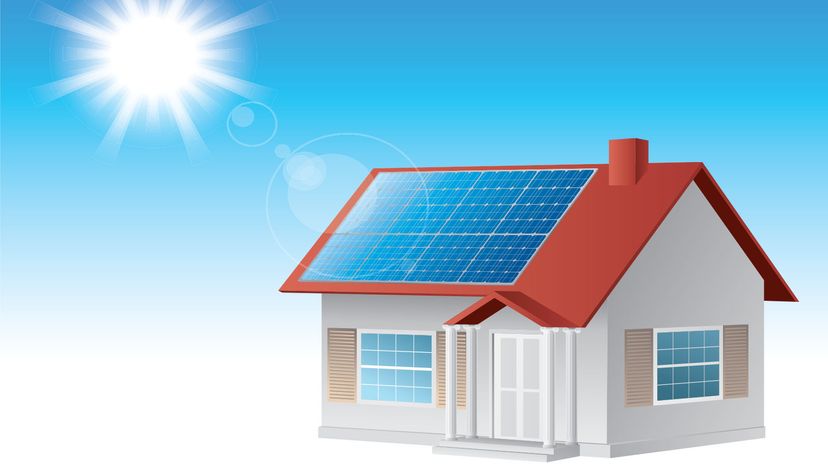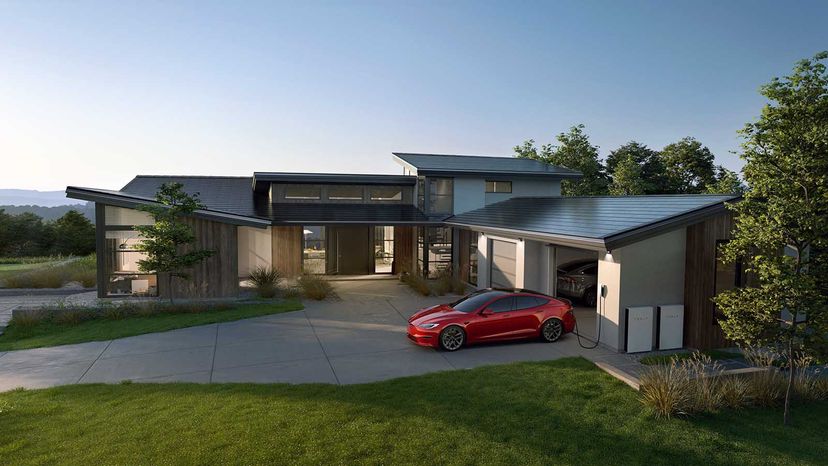Why wouldn’t everyone want to convert their family homestead to function off the sun’s rays? Sounds like quite the formula for happiness, right? Deciding to go solar can have some pretty big benefits. But be careful: There’s lots to think about before you cut the cord with your local utility provider.
Solar power is free (after the initial investment of setting up the system and your maintenance costs). Solar power is efficient (although how efficient is debated by some experts). Important to many of us in these days of climate change: Solar energy is also free of pollution.
But the initial costs of getting set up for solar power can be daunting. And once you decide to go fully solar, you may have to cope with foul weather, which could put a damper on your plans to live solely off the sun.
When you use solar panels, you can still get power provided by the utility company in situations where you can’t get enough electricity or don’t have any power stored. But the ultimate goal for many is to eliminate the need for fossil fuels entirely, to boot the fossil-fueled utility companies and to live a sun-powered life.
Planning to run your house completely on solar power requires considerable financial, mental and emotional investments. The infrastructure is a little more complicated than the traditional setup. The calculations of building your new system and running it must be more precise. A mistake can leave you without enough juice to get by.
But running a house completely on solar power is absolutely doable.
Concentrating the Sun’s Rays

The first practical instance of controlling the sun’s energy might have been when someone noticed that glass, held at the right angle, could set fires and burn ants. We’ve come a long way.
The first silicon photovoltaic cell was produced in the United States in 1954. Our current solar panels are a direct descendant of that technology. They’ve just been made more efficient over the years.
From the 1950s, various residential and commercial buildings were developed with different solar priorities. One office building gained recognition for solar water heating. Residential milestones went from sunrooms to hybrid solar/grid systems to standalone fully solar homes (the first of which was completed in 1983 in New York’s Hudson River Valley). In 2000, a Colorado family built a solar installation that nearly completely powered their home for its eight-member family.
Other useful innovations, besides roof-mounted solar panels, have popped up, including a modified version of a radiant heating system. By carefully routing the home’s plumbing, water can be heated by the sun and, as the water is pumped through the house, the heat can be dissipated to help control the house’s temperature. The beauty of that: It doesn’t add to the home’s electric consumption. In a nationwide solar home design competition in 2007, a group of students from Santa Clara University in California figured out how to use a solar radiant heat system to help cool the house as well as heat it.
The idea is appealing, but it’s been sometimes difficult to execute. Luckily, continuing innovations over the past decade-plus have made affordable, highly efficient solar power more readily available to more people throughout the world.
Cost, of course, can make or break any solar energy initiative. It can still be an issue for many. The price of early solar technology held fairly steady then dropped by about 80 percent in the 1970s. In February 2009, First Solar, a manufacturer of solar panels, announced that the cost to make its wares had dropped to a dollar per watt — an eagerly anticipated milestone.
These days, the cost of a solar panel outfit for a home costs an average of $16,000 (and can go as high as $35,000), depending on the type of panel. Installation isn’t included: That can be as much as $25,000 [source: Forbes]. Other costs, like financing and permitting, can be additional.
Savings, though, can be significant. How much money a homeowner can sock away by reducing their reliance on the grid varies, in large part because energy costs vary widely. Online tools like EnergySage and PVWatts can help estimate costs and savings of installing and running a solar system [source: U.S. Department of Energy].
Experts say that “grid parity” is the necessary milestone to making solar power really work. Grid parity is achieved when solar power costs the same as — or is cheaper than — conventional power, without the help of the grants, subsidies and rebates that make it possible for many customers. Already in large parts of the world — places like China, many countries in Europe, and in the state of California — experts believe that grid parity has been reached [source: PV Magazine]. When more places obtain grid parity, the supply probably won’t be able to keep up with demand, since some of the solar panels’ raw materials are hard to obtain in large quantities [source: Hutchinson].
Like Vitamin D for Your House

To envision how solar power can provide enough juice for an entire house, it’s necessary to cover a bit of the basics. We’ve probably all seen the more traditional solar panels by now — flat, glare-inducing, unwieldy looking things that sit on rooftops.
Solar panels capture whatever sunlight is available and convert it to DC power. An inverter converts the DC power to AC power (which is what we use to power electronic devices). For people who want to completely power an entire home with the sun’s rays, there are systems available to convert and store extra power in the form of battery energy. This way, the house still can have a source of power at night or in poor weather (though it can’t cover the shortfall of a poorly designed or inadequate system).
Solar shingles are also a subtle, streamlined alternative to the older, bigger panels. They are made from the same materials as traditional solar panels, act as traditional roof shingles and look pretty much like a regular roof … perhaps just a bit shinier. Contrary to popular belief, the newer panels can work even in weak or scattered sunshine conditions.
So why does converting to solar sometimes take a bit of persuasion? Generally, houses in the United States get heat either from gas or from electricity, usually provided by local utility companies. Let’s assume that someone gung-ho on going solar wants off the grid entirely — no gas or electricity from the utility companies. The electricity provided by solar power, then, needs to accommodate for heating, air conditioning (which, by far, is one of the biggest drains of power in a house), other parts of the house’s infrastructure like lighting and vent fans, all major appliances (refrigerator, stove, washer and dryer) and other electronics like the stereos, televisions and computers. (This list, of course, is by no means comprehensive: How many members of your family need to constantly charge their smartphones or tablets?)
If your house is huge or you’re a power hog who leaves the electronics on all day, you’ll need a more intense solar setup. It would be nice to assume that those serious about performing this conversion already are pretty conscious of consumption and making an effort to reduce power usage, like using insulated window shades instead of cranking the a/c, or foregoing a dishwasher that heats up and churns for hours. As solar goes more mainstream, though, the eco-conscious early adopters might not be the majority. They’ll want a more robust solar system.
The smart consumer calculates electricity use, then assembles a solar panel setup that can meet that demand. If the setup seems like too much, cutting back on consumption might be in order.
Though it’s certainly complicated and can be expensive, people with the resources to design and build a solar-powered home from scratch have some advantages. A lot of subtleties come into play when planning a residential solar system for a specific existing house. The actual design of the house is one such factor. How big is the roof’s surface (which affects its potential solar surface area)? What direction does the roof face, and what’s the degree of its pitch? Are there obstructions that cause partial shade?
Location is also a factor. A house in Scandinavia, with its notoriously short days, won’t fare as well as a house near the equator. The average number of sunny days matters too; if it’s raining until nightfall, it doesn’t particularly matter if nightfall comes late. If you’re building your own solar-powered dream house, you’ll have more say over some of those variables.
When you’re trying to figure out how much power you can produce with your new solar setup, and how much you’ll need, it’s helpful to look at meteorological data for your area, too. It’ll show you how much sunlight you can expect in any given month, based on past averages. You should have copies of your utility bills nearby, which will let you know how much power you consume. You can use all this information to figure out if the system you want will make enough electricity.
General guidelines recommend a setup that generates 1 kilowatt per 1,000 square feet (93 square meters) of house. But don’t let your optimism take over — you need to ensure you can produce enough power to get you through the worst times, not the best. You’ll want to literally prepare for the proverbial rainy day.
Paying for What’s Free
The sun’s rays are available to anyone, but it takes a lot of expensive equipment to turn them into power. But solar panels are now among the least-expensive forms of renewable energy.
Most large-scale solar projects are now significantly cheaper than coal plants [source: World Economic Forum]. Huge savings on a big scale may not yet translate to smaller projects like homes. But if you’re serious about making the switch, don’t let that discourage you — there might be ways to make it happen.
Energy-related incentives and rebates vary so much, and change so frequently that anyone considering a solar home conversion should take a close look at state-specific benefits. The right combination of grants, tax credits and per-watt rebates might make the initial investment more affordable than many homeowners think.
In 2020, Congress passed an extension on the Solar Investment Tax Credit (ITC) — a so-called “solar tax credit” — for newly installed solar panel systems. It reduces federal income taxes by allowing for a percentage of the cost of a photovoltaic (PV) system. There is no maximum credit. The ITC, though, expires in 2024 unless it’s renewed by Congress again [source: U.S. Department of Energy].
You also might be eligible for credits from states or localities. Local utility companies also might offer financial incentives to install a system. If you ever want to sell your solar-powered home, the investment could pay off big-time. As utility costs rise and your neighbors pay more for power, you might actually be entitled to a refund from your utility company, something that would be attractive to a potential buyer.
If your solar panels make more power than your house uses, you can sell your extra power back to the grid. Companies that install residential solar power tout this benefit as an easy way to recoup your investment, and it would be attractive to buyers, but the results can vary (as do the laws governing what the utility companies can do) depending on where you live.
Some locales have tried to bring solar power to the masses. Berkeley, California, and Boulder, Colorado, have municipal solar programs in which the cities make the infrastructure investment and recoup the cost through taxes. Other locales offer special loans that are paid back through additional property taxes. And at least one company has come up with a leasing program (kind of like leasing your cable box or satellite dish from your cable company) focusing on states that have particularly high energy costs to appeal to as many consumers as possible.
The path to cheap, easy solar power has not been, well, easy. Germany once provided more than $130 billion in solar power subsidies, only to decide in 2012 that those benefits would be phased out. The infrastructure, officials said, was too expensive and inefficient to use on a large scale, even if the sun’s rays are free.
But in 2020, solar rooftop installation grew by 25 percent in Germany, and the government now aims to double its solar power plant capacity by the end of the decade [source: PV Magazine].
So even in places that have struggled to make a go of solar power, it’s time to go outside and celebrate. If you want to convert your house to full solar power, the technology is there.



